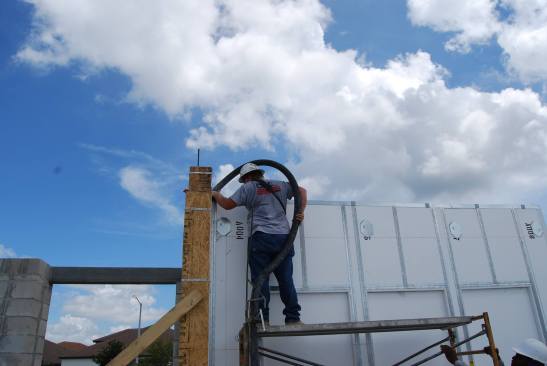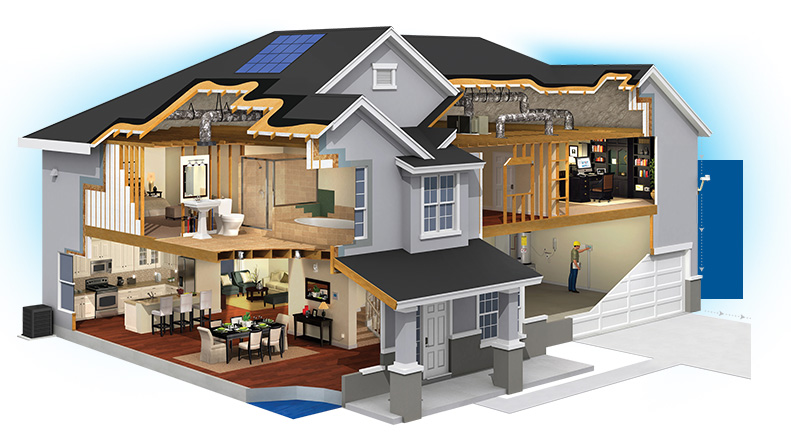All ideas need a passionate ambassador to become a reality, to become mainstream and loved by the public. Sometimes, that’s what it takes to change the world.
One of my favorite stories is how Phil Knight started Nike. He penned his own book called Shoe Dog, which talks about him loving to run at a time when it wasn’t a general pastime. Knight’s love for running inspired a passion for finding the right running shoes. And although he didn’t know entirely how to run a business and had many failures along the way, he was able to create one of the most recognizable brands in history.
Knight’s passion not only created a brand, it created a passion for a national pastime and for healthier living. People were buying Nikes to be in the “in” crowd.
What does this have to do with housing? One individual wants to change the world by building homes differently–by rethinking the way homes use energy.
CR Herro, vice president of environmental affairs at Meritage Homes, explains that buildings consume more energy than anything else in the United States. And it’s mostly due to one operation: heating and cooling. Herro calls that the “elephant in the power grid.”
The Waste
The U.S. Energy Information Administration reports that in 2016, about 40% of total U.S. energy consumption was from residential and commercial sectors and that these sectors account for nearly all of the energy consumption in U.S. buildings.
Through this year’s BUILDER Concept project, the reNEWable Living Home, Herro is attacking this issue head-on. Heating and cooling demands the most energy in buildings, but 50% of that energy is wasted, he says. An average building wastes 50% of its HVAC energy demand due to poor insulation; the other 50% contributes to controlling the temperature, Herro says.
The problem is compounded by the diurnal cycle. The sun comes up and heats up the ground. At 4 p.m., when it’s as hot as it’s going to be for the day, the cycle peaks. Then, it starts a slow descent to go through another 24-hour cycle. That peak and valley causes a peak and valley in the pull on the grid. Up to 600% more energy is consumed at peak than at valley, reports Herro.
The changes from peak to valley have to be compensated for by utility providers, with a system that produces that much more energy at 4:00 in the afternoon than 4:00 in the morning. In today’s system, the utility runs on generators and has to turn on the correct number of generators to match the demand. The yo-yo act of bouncing between one and 10 generators costs the utility industry trillions of dollars, which are ultimately passed on to the consumer.
So, who’s doing the math? Add up the waste of heating and cooling plus the waste of the utility industry’s management to equal a very wasteful system. Here’s where Herro really layers on the passion.
“All [these] things can be fixed,” he says. “They are all the cause of the industry becoming lazy, and because there was a disconnect between occupants and architects. It’s all solvable at a very cost-effective level. We need to start to design and operate homes like a utility company.”
As a firsthand witness of what Herro has been doing since 2012, Ram Narayanamurthy, technical executive at the Electric Power Research Institute (EPRI), says that Meritage is one of the most progressive builders on the energy arena today. One aspect that Meritage does really well is the high performance envelope, he says, because it’s important to reduce the amount of heating or cooling that is required for a home before you put in solar or renewable energy sources.
“Most homes are a 50- to 100-year asset. If you build it right, then it stays for a much longer period of time,” Narayanamurthy says. “A big focus area is getting high-performance envelopes with better insulation and getting the ducts into conditioned space. A lot of loss happens because the duct system is leaky or in the attic. Getting insulation around the duct can substantially reduce the loss. Meritage has been working since 2010 to 2011 to put in high performing attics.”
He also speaks to the ebb and flow of demand for utilities, which is caused by different times of the day, different times of the year, and even the variety of needs in different geographies. Storage can help offset those peaks, Narayanamurthy says. Many solutions tend to focus on battery storage, but most people overlook how the building can store energy. Not Herro.
The Solution
Like Knight with his Nikes, Herro is developing the product that solves his passion. In the reNEWable Living Home, he’s re-envisioning how energy management should be designed in a home.
First, the design must account about load management, starting with what causes peak energy demand. What uses power at 4 p.m., and what could be shifted to 4 a.m. to level the load?
The reNEWable Home has smart appliances that will be programmed to run in the middle of the night, off peak hours, washing dishes or clothes while the homeowner is asleep. Plus, the home will showcase a new ventilation system from Aprilaire with control technology that can shift energy usage to off peak. Lighting controls will operate through a home automation program that turns them off automatically during peak hours. Plus, using more efficiency strategies, the homeowner can proactively cool the home in the summertime before the peak, therefore using the home as a thermal battery.

Meritage uses a new concrete wall construction for the reNEWable Living Home with better energy performance than wood.
Next, Herro talks about ways to improve the thermal envelope to minimize the huge waste of energy in a typical home. The home will be designed with a strong thermal envelope, so it’s airtight. It also will be designed to manage thermal mass, or store the cold in the summer and warm in the winter. Instead of building with wood, which has very low thermal mass, this home will be built with concrete.
When it’s hot the concrete will store heat and release it later, shifting the cooling demand to the nighttime. It does the same in winter, storing the cold in the middle of the night and then releasing it later in the day.
The last piece of the efficient home design is a thermal battery that helps even out energy consumption. Solar roof tiles feed an in-home battery, which can power the home instead of the grid.
The Restructure
Designing homes this way may help utility providers rethink how they are charging for energy. Herro suggests that if utilities push higher prices during the peak, home builders and homeowners will be forced to think about managing peak consumption better.
“Moving to this system could cut the cost of energy by 75% per home,” says Herro. “The hope is that with this home, we can drive a new policy for utilities to incentivize builders to build this way.”
A recent CNET article outlined how this evolution would happen.should we link to this article?
Scrapping or adjusting net metering could push people to buy batteries for storing energy generated at home. And charging lots more for power during high-demand hours — an increasingly common billing strategy — could eventually make batteries more economical. If tariffs and regulations do change, expect a “tremendous expansion” in home storage, says Loic Gaillac, senior manager of the advanced energy storage group at Southern California Edison.
As millions of homes light up the power network, utilities will adapt or die, Lazar says. “That evolution is inevitable, necessary and under way.”
Not only will there be cost savings for the homeowner and the utility system, but the homes will be more comfortable, consume energy more consistently, and be less costly to operate.
“If all buildings worked that way, then a utility could reduce its KW to the market by 75% and still make money,” Herro says. “The cascade effect could move trillions of dollars into the U.S. economy. That money could go into social programs and change the entire world. We can do that with this house as a template and change the way the world works.”
“We need homes that are more in tune with the overall management system,” Narayanamurthy says. “We can design better to build homes with much more thermal mass, and then use smart home management systems to leverage them. Wireless thermostats also help leverage and exploit the storage capacity of the homes. Now these thermostats provide a huge amount of capability.”
The future of at home load management is explored through the BUILDER concept home, reNEWable Living Home, which will be on display in January in Orlando. You can follow the design and the construction of the home now by visiting www.builderonline.com/renewable.



